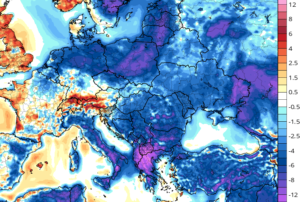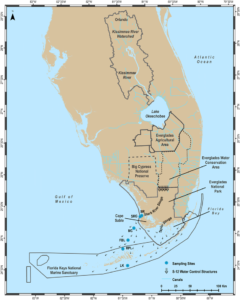by Cap Allon, July 19, 2019 in Electroverse
On the back of Russia’s horde of new record low temperatures set on July 12, a bucket-load more were set over the following few days, busting records that had previously stood for well over 100 years.
The mercury across the majority of Europe has remained well-below average during the month of July as a string of Arctic blasts continue to delay the start of the continent’s summer. Large regions are seeing temperature departures of up to 20C below average, sending all-time cold records tumbling.
…
And now Russia has 7 more daily records to add to the ever-expanding list (data courtesy of www.hmn.ru):
- Sortavala recorded 3.8C (38.8F) — busting the previous record of 4.2C (39.6F) set in 1971.
- Vytegra’s 0C (32F) beat the previous record of 1.5C (34.7F) from way back in 1893.
- Vyborg observed 6.7C (44F) surpassing the 7C (44.6F) set in 1978 (solar minimum of cycle 20).
- Roslavl’s 7C (44.6F) beat out the 7.9C (46.2F) from 1935 (solar minimum of cycle 15).
- Cherepovets‘ 4.1C (39.4F) busted the 4.8C (40.6F) set in 1995 (solar minimum of cycle 22)
- Rybinsk registered 7.2C (45F) smashing the previous record low of 9.9C (49.8F) from 1977 (solar minimum of cycle 20).
While Kostroma’s 5.7C (42.3F) beat 1948’s record of 6.9C (44.4F).

by Olbrew, July 20, 2019 in Tallbloke’sTalkshop
While many richer countries play fake climate games with their so-called ‘virtue signalling’ energy policies, the not-so-well-off majority try to get more access to those same power sources which are so necessary for better living conditions, e.g. air conditioning in hotter countries, and for general prosperity and health: more schools, hospitals, roads and all the rest.
Global power consumption will more than double over the next 30 years, says The Global Warming Policy Forum (GWPF).
Global oil and gas demand will respectively surge 22% and 66% from 2020 to 2050. There’s an unimaginable urbanization boom occurring around the world that means more energy use.
We, of course, don’t see much of it here in the West, but global cities swell in population by some 80 million people every year: e.g., the rise of the “megacity” with 10 million residents.
Basically all population growth in the decades ahead will take place in urban areas, all of which will be in the still developing nations (non-OECD), where poverty and insufficient access to energy is far more rampant than our worst nightmares could ever imagine.
…

by Carly Cassella, July 20, 2019 in WUWT
Coral reefs are one of the most threatened ecosystems on our planet, and in the past two decades alone, half of the coral in Florida has died off completely. Global warming is known to be a deadly factor, but rising ocean temperatures are only part of the story.
Thirty years of research in the Looe Key Sanctuary Preservation Area (LKSPA) on the southern tip of the Florida Keys has now revealed the cost of a devastating threat to coral that rivals even climate change: direct human pollution.
For years, agricultural run-off and improperly treated sewage have flowed into Florida’s ocean waters from the northern Everglades, elevating the sanctuary’s nitrogen levels and lowering the reef’s temperature threshold for bleaching, researchers say.
As a result of this deadly combination, coral cover in the region has declined from nearly 33 percent in 1984 to less than 6 percent in 2008.
In their analysis, the authors found that three mass bleaching events that occurred during these years only happened after heavy rainfall and increased land-based runoffs. In other words, if we can reduce the amount of local pollution that makes its way into our oceans, we might be able to reduce the worst of the damage.
…

Klein & Orlando, Bulletin of Marine Science, 1994
La géologie, une science plus que passionnante … et diverse



